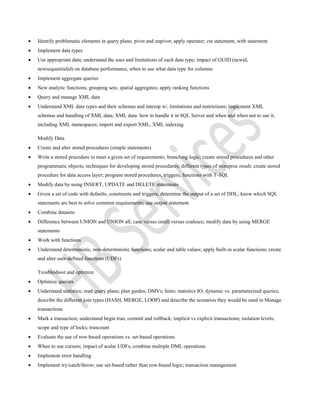Querying microsoft sql server 2012
- 1. Hi, Global Certification: Microsoft SQL Server 2012 Exam Code: 70-461 Program Name : Querying Microsoft SQL Server 2012 Description: Microsoft SQL Server is a relational database management system developed by Microsoft. As a database server, it is a software product with the primary function of storing and retrieving data as requested by other software applications which may run either on the same computer or on another computer across a network (including the Internet). Training Content Create database objects Create and alter tables using T-SQL syntax (simple statements) Create tables without using the built in tools; ALTER; DROP; ALTER COLUMN; CREATE Create and alter views (simple statements) Create indexed views; create views without using the built in tools; CREATE, ALTER, DROP Design views Ensure code non regression by keeping consistent signature for procedure, views and function (interfaces); security implications Create and modify constraints (simple statements) Create constraints on tables; define constraints; unique constraints; default constraints; primary and foreign key constraints Create and alter DML triggers. Inserted and deleted tables; nested triggers; types of triggers; update functions; handle multiple rows in a session; performance implications of triggers Work with data Query data by using SELECT statements Use the ranking function to select top(X) rows for multiple categories in a single query; write and perform queries efficiently using the new (SQL 2005/8->SDL-->) code items such as synonyms and joins (except, intersect); implement logic which uses dynamic SQL and system metadata; write efficient, technically complex SQL queries, including all types of joins versus the use of derived tables; determine what code may or may not execute based on the tables provided; given a table with constraints, determine which statement set would load a table; use and understand different data access technologies; case versus isnull versus coalesce Implement sub-queries
- 2. Identify problematic elements in query plans; pivot and unpivot; apply operator; cte statement; with statement Implement data types Use appropriate data; understand the uses and limitations of each data type; impact of GUID (newid, newsequentialid) on database performance, when to use what data type for columns Implement aggregate queries New analytic functions; grouping sets; spatial aggregates; apply ranking functions Query and manage XML data Understand XML data types and their schemas and interop w/, limitations and restrictions; implement XML schemas and handling of XML data; XML data: how to handle it in SQL Server and when and when not to use it, including XML namespaces; import and export XML; XML indexing Modify Data Create and alter stored procedures (simple statements) Write a stored procedure to meet a given set of requirements; branching logic; create stored procedures and other programmatic objects; techniques for developing stored procedures; different types of storeproc result; create stored procedure for data access layer; program stored procedures, triggers, functions with T-SQL Modify data by using INSERT, UPDATE and DELETE statements Given a set of code with defaults, constraints and triggers, determine the output of a set of DDL; know which SQL statements are best to solve common requirements; use output statement Combine datasets Difference between UNION and UNION all; case versus isnull versus coalesce; modify data by using MERGE statements Work with functions Understand deterministic, non-deterministic functions; scalar and table values; apply built-in scalar functions; create and alter user-defined functions (UDFs) Troubleshoot and optimize Optimize queries Understand statistics; read query plans; plan guides; DMVs; hints; statistics IO; dynamic vs. parameterized queries; describe the different join types (HASH, MERGE, LOOP) and describe the scenarios they would be used in Manage transactions Mark a transaction; understand begin tran, commit and rollback; implicit vs explicit transactions; isolation levels; scope and type of locks; trancount Evaluate the use of row-based operations vs. set-based operations When to use cursors; impact of scalar UDFs; combine multiple DML operations Implement error handling Implement try/catch/throw; use set-based rather than row-based logic; transaction management


